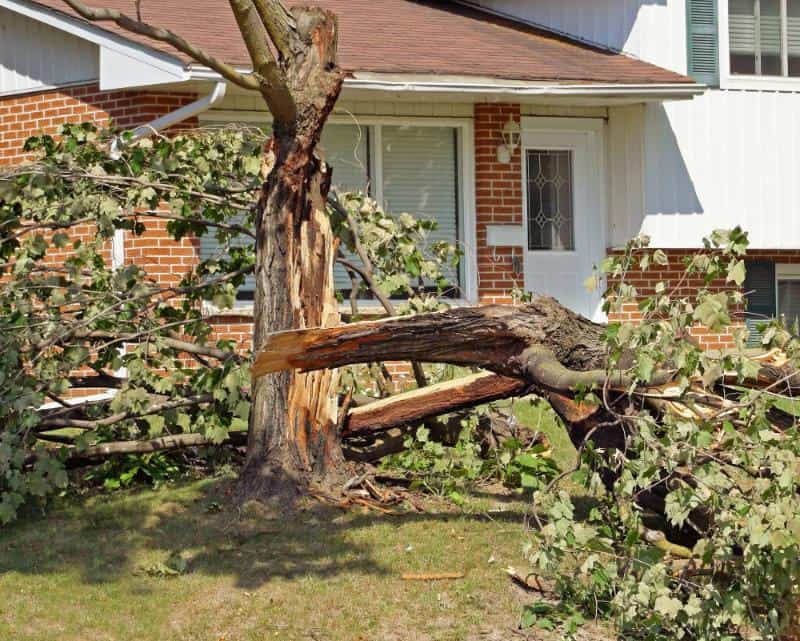The loud crack of a falling tree can be an worrisome sound. But when it’s followed by the noise of your roof giving way, you’re in real trouble. Whether due to a storm’s fury or nature’s negligence, this type of event isn’t just a matter of inconvenience – it’s a matter of safety and security. Even in your shock, it’s important to keep a clear head and know the next steps. Below, we’ll cover the key actions you should take if a tree unexpectedly falls on your roof.

1) Safety First, Assess the Situation
Safety must always be your top priority. Immediately after the tree lands on your home, check to make sure everyone is okay. If there are any injuries or someone is trapped, call for emergency assistance right away. Do not attempt to move large branches or heavy debris unless you’re confident it’s safe to do so. Even the most rugged limbs can shift unpredictably, posing significant risks to personal safety and structural integrity.
2) Let Experts Inspect The Damage
Before taking any repair steps, it’s important to have a detailed inspection conducted by professionals who can accurately assess the extent of the damage. This ensures a proper evaluation of the situation and prevents potential safety hazards that could arise from unseen structural compromises. Hiring experts like Kingfisher Roofing enables homeowners to receive an expert appraisal of the damage, ensuring that all issues, not just the immediately visible ones, are identified and addressed. These specialists bring a wealth of experience in dealing with tree-related damages and can offer invaluable advice on the necessary repairs or replacements, ultimately saving time, and money, and ensuring the structural integrity of your home is restored.
3) Protect Your Home
Your next move is to minimize the damage that water or the elements can do to your home. If you have a tarp or large waterproof sheeting available, carefully cover any exposed areas of the roof to keep rain out. This action can prevent further issues such as water damage, mold, or pests from entering your home. Be cautious as you approach these tasks; you have to maintain a careful watch for downed power lines and other hazards.
4) Document the Damage
Once you’ve ensured everyone’s safety and protected your home, it’s time to document the situation. Take photographs or videos of the tree, the damage to your roof, and any affected interior areas of your house. This visual evidence can be pivotal in the insurance claims process. Remember to make your documentation as thorough as possible, capturing multiple angles and close-ups of the damage.

5) Check Your Insurance Policy
The moment it’s safe to do so, initiate contact with your insurance provider to report the incident. They’ll walk you through the specifics of the claim filing process and the documentation required. Don’t forget to inquire about both the structural damage to your property and any affected personal belongings, as coverage might differ. Some policies may also provide for temporary living expenses if your home is deemed uninhabitable. Beware, though, as there could be clauses or deductibles that affect how much compensation you’re eligible for.
Additionally, if the fallen tree originated from your neighbor’s property, your insurance company might pursue a claim against their insurance, which could influence the dynamics of your claim. Understanding these intricacies can make a substantial difference in your financial recovery and the speed at which repairs can commence.
6) Secure Temporary Shelter
When a tree compromises the safety and structural integrity of your roof, finding alternative living arrangements becomes an immediate priority. Should your home be deemed unsafe, you need to have a backup plan for where you and your family can stay. Options might include staying with relatives or friends, reserving a hotel room, or if feasible, utilizing undamaged parts of your property as a makeshift living area.
You’ll want to make sure your family’s routine is disrupted as little as possible during this stressful time. Educational needs, proximity to work, and access to essential services should all factor into your decision-making process. Prioritizing comfort and stability can significantly reduce the emotional and psychological stress associated with such sudden displacements. Additionally, having a well-thought-out plan for emergencies well before they occur can substantially ease the burden of finding last-minute accommodations.
Although a tree caving in your roof can be shocking, being prepared will help you get through the ordeal. By following these guidelines, you can ensure a swift and safe resolution to this unexpected chapter. Remember, having a good insurance policy and a pre-planned method for securing your home post-incident is always a wise investment in the future of your home’s security and your peace of mind.
